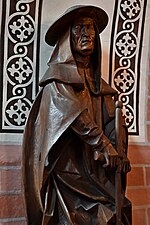Güstrow Dom
Appearance
| Güstrow Dom | |
|---|---|
| Minster/Collegiate church of St. Mary, St. John the Evangelist and St. Cecilia | |
Dom St. Maria, St. Johannes Evangelista und St. Cäcilia | |
 | |
 | |
| 53°47′28″N 12°10′24″E / 53.7910°N 12.1734°E | |
| Location | Güstrow |
| Country | Germany |
| Denomination | Evangelical Lutheran Church in Northern Germany |
| Architecture | |
| Style | Brick Gothic |
The Dom ("cathedral") is a Brick Gothic Lutheran church, the largest church in the German city of Güstrow. It was built as a collegiate church and has never actually been a cathedral. Initially completed in 1335, the church is the oldest extant building in Güstrow.[1] It houses the sculpture Der Schwebende ("The Floating One"), a war memorial created by Ernst Barlach.[2] The apostle figures by Claus Berg, called the Güstrow Apostles, are also famous.

Gallery with the Apostle figures by Claus Berg
[edit]-
Andreas with the cross
-
Bartholomäus with the knife
-
Jakobus the older one with the pilgrim's hat
-
Jakobus the younger one with the walker
-
Johannes with the poison chalice
-
Judas Thaddäus with the halberd
-
Matthäus with the dipstick
-
Matthias with the hatchet
-
Petrus with the keys
-
Philippus with the cross
-
Simon with the saw
-
Thomas with the lance
External links
[edit]- Dom zu Güstrow website (in German)
References
[edit]- ^ "Barlach Town Güstrow". European Route of Brick Gothic. Archived from the original on 13 November 2014. Retrieved 6 November 2014.
- ^ Malik, Kenan (23 October 2014). "Germany's History Lesson for Britain". The New York Times. Retrieved 6 November 2014.












